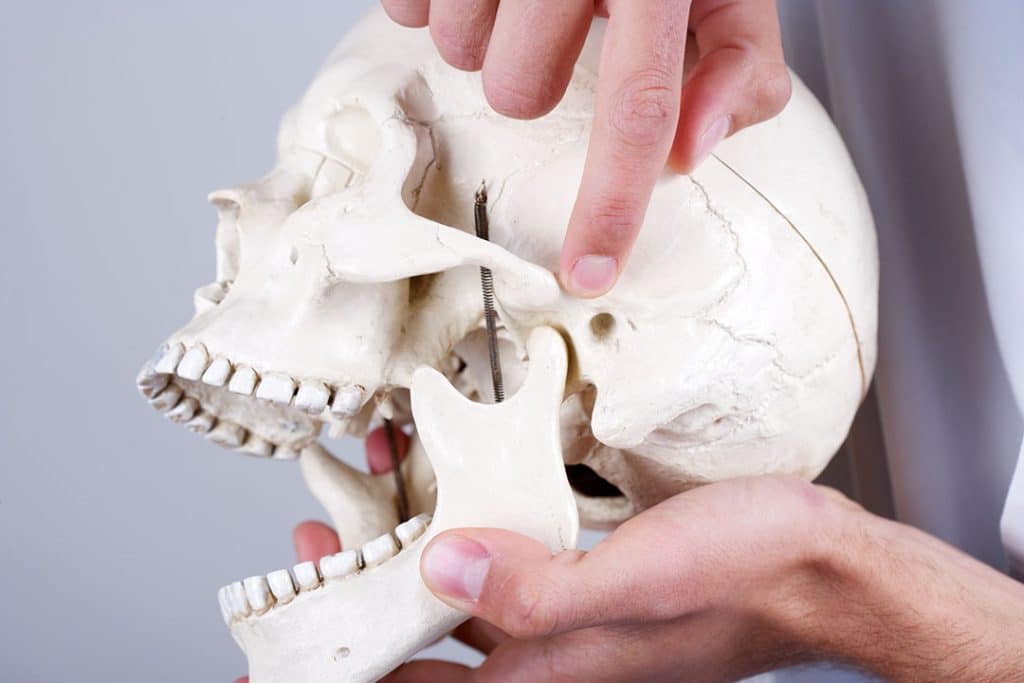Learn how to get to the root cause of TMJ and jaw pain and find lasting relief with chiropractic care.
When we feel good, we often take simple things for granted. Things like opening your mouth for a bite of your favorite sandwich or yawning without a side of jaw pain.
If you’re struggling with a TMJ (temporomandibular joint) disorder, the idea of chewing, yawning, or even laughing painlessly might feel like a dream.
TMJ disorders affect between 5-12% of the population, and cause irritating headaches, jaw pain, and other issues. The good news is that while these issues can be frustrating, relief might be closer than you think – without the need for invasive treatments.
This is where chiropractic care comes into play. Let’s dive into how this natural approach can stop TMJ pain naturally and keep it from coming back.
Understanding Temporomandibular Joint (TMJ) Disorders

TMJ disorders are rooted in an imbalance in the structure or function of the Temporomandibular Joint (TMJ). This joint acts as a sliding hinge that connects your jawbone to your skull. Thanks to your TMJ, you can talk, sing, chew, breathe, and make facial expressions.
Disorders of this joint—a collection of conditions known as TMJ disorders—can lead to pain, dysfunction, and a significant decrease in your overall quality of life. Disorders in this joint can lead to pain, difficulty chewing, and discomfort in your jaw, ear, and sometimes, your entire face. The simple act of enjoying a meal can quickly turn into a painful challenge with a TMJ disorder, and constant jaw pain can interfere with your focus at work or your ability to sleep.
But how do these issues develop?
Common Causes of TMJ
Unlike other conditions where the cause can be easily pinpointed, TMJ disorders often develop from a combination of these factors:
> Teeth Grinding
Also called bruxism, this is an unconscious habit that can happen anytime, but especially during sleep or stress. Grinding puts excessive pressure on the TMJ, leading to pain and damage over time.
> Arthritis
Just like any other joint in your body, the TMJ can suffer from arthritis. Inflammation from osteoarthritis and rheumatoid arthritis can degrade the joint, causing pain and limiting movement.
> Injury
A direct blow or trauma (from whiplash, sports injuries, or accidents) to the jaw, head, or neck can disrupt the harmony of your TMJ.
> Stress
High stress levels can lead to tight facial and jaw muscles. This increases the strain on the TMJ and promotes habits like teeth grinding.
> Dental Problems
From misalignment to missing teeth, dental issues can indirectly cause TMJ disorders.
> Poor Posture
Chronic neck and shoulder tension from poor posture can extend to the muscles and joints of the jaw, contributing to TMJ disorders.
> Chewing Gum or Hard/Chewy/Sticky Foods
Excessive chewing can overwork the jaw muscles, leading to fatigue and pain in the TMJ.
> Nail Biting
Similar to gum chewing, nail biting places unnecessary stress on your TMJ and is often a sign of underlying stress.
Common Symptoms of TMJ Disorders
Not all TMJ disorders look and feel the same. While pain is a common thread, there is a wide range of possible symptoms and manifestations of TMJ disorders:
- Jaw pain or tenderness
- Pain in and around the ear
- Difficulty or discomfort while chewing
- Facial pain
- Clicking or grating sounds
- Headaches/migraines
- Neck and shoulder pain
Conventional Treatments for TMJ Disorders
To really get to the root of TMJ disorders, we need to take a multifaceted approach that’s tailored to your specific symptoms and causes. This is where chiropractic care shines. But first, let’s take a look at the other conventional treatments that are typically recommended:
> Medications
Over-the-counter pain relievers and anti-inflammatories can provide immediate relief for some symptoms. In more severe cases, your doctor may prescribe stronger medications, muscle relaxants, or even antidepressants for pain management.
> Oral Splints or Mouth Guards
These are devices that can be fitted over the teeth to help alleviate the pressure on the jaw. They can also prevent teeth grinding, which is especially useful for those whose TMJ pain stems from bruxism and stress.
> Dental Intervention
For TMJ disorders caused by bite issues or teeth alignment, orthodontic treatments, or other dental solutions may be recommended.
> Surgical Procedures
As a last resort, various surgical options are available, ranging from minimally invasive procedures like arthrocentesis (the flushing of the joint) to more involved surgeries such as TMJ arthroscopy or open-joint surgery. These are considered when all other treatment options have failed to provide relief.
Non-Traditional, Non-Invasive Treatments
Choosing a treatment plan is extremely personal, and each of these options carries its own set of benefits and potential risks. For example, relying on medications can give you quick relief, but come with the risk of side effects or dependency. And while surgery may offer a more permanent solution, there are inherent risks to all surgical procedures.
Non-invasive therapies like chiropractic care, physical therapy, stress management, and lifestyle change may take a bit more time to offer relief than these conventional methods. But these treatments are more likely to get to the root cause of your TMJ and take a safer, more natural approach for lasting relief.
Let’s dive deeper into how chiropractic care can help you overcome your TMJ without the need for more invasive treatments.
Chiropractic for TMJ Disorders

Chiropractors understand that the body is an intricately connected being, and imbalances in one area can affect the rest of the body. This is especially true when it comes to the spine. With this perspective, chiropractic care offers a unique approach to treating chronic pain conditions like TMJ by addressing not just the symptoms but the root causes of pain.
This holistic approach is exactly why many are turning to chiropractic care to manage their TMJ. Along with getting personalized, effective relief, you don’t have to worry about the risks and side effects associated with surgery and pharmaceuticals. By focusing on the body’s natural healing abilities and providing a comprehensive plan that includes adjustments, muscle release techniques, and lifestyle modifications, chiropractic care presents a safe, complementary option that can either stand alone or integrate seamlessly with your other treatments.
Chiropractic Treatments for TMJ
So, how does it work? Chiropractic treatment for TMJ aims to correct misalignments in the spine and the temporomandibular joint, improving function and reducing pain. Here’s how:
> Jaw Adjustment
Chiropractors can perform adjustments specifically targeting the temporomandibular joint. This involves gently manipulating the jaw to improve alignment and mobility, which in turn relieves pressure and reduces inflammation.
> Spinal Alignment
Misalignments in the spine can affect posture and muscle tension throughout the body, including the jaw. By correcting these spinal issues, chiropractors can indirectly alleviate TMJ symptoms by reducing overall tension and promoting better posture.
> Muscle Release Techniques
Chiropractors use various techniques to relax and stretch the muscles around the jaw and neck. This can include manual therapy, trigger point therapy, and specific exercises that target and re-balance the muscles involved in TMJ disorders.
> Effective Self-Care Practices
Your AlignLife chiropractor is here to help you inside and outside the center. We also provide guidance on exercises, nutrition, and ergonomic adjustments to help you manage your symptoms at home to prevent future TMJ issues.
Benefits of Chiropractic Care for TMJ Disorders
So, how does it work? Chiropractic treatment for TMJ aims to correct misalignments in the spine and the temporomandibular joint, improving function and reducing pain. Here’s how:
> Pain Relief
Your AlignLife chiropractor can identify and directly target the source of your discomfort through specific adjustments and manipulations of the jaw and related areas. This precise approach not only alleviates pain but also helps to restore normal function to the temporomandibular joint.
> Enhanced Jaw Function
Improving the jaw’s mobility and reducing stiffness is a crucial step in healing your TMJ. Through a combination of adjustments and therapeutic exercises tailored to your specific condition, chiropractic care helps normalize the movement of your jaw. This not only improves the ability to chew and speak comfortably but also decreases pain and discomfort during everyday activities.
> Reduced Inflammation
Inflammation is almost always involved in the pain and discomfort associated with TMJ disorders. Chiropractic care addresses this directly by using techniques that reduce inflammation in and around the temporomandibular joint. Certain adjustments and manipulations can enhance circulation and improve lymphatic drainage in the area. This helps to decrease swelling, inflammation, and pain.
> Root-Cause Treatment for Long-Term Solutions
Perhaps the most significant benefit of using chiropractic care to manage your TMJ pain is its focus on addressing the underlying causes of the disorder, rather than merely treating the symptoms. Your treatment plan is geared towards correcting the root issues, such as misalignments, muscle tension, and poor posture, that contribute to TMJ disorders. By doing so, chiropractic care not only provides immediate relief but also works towards preventing TMJ issues in the future.
More Natural Ways to Manage or Get Relief from TMJ

Chiropractic care offers a solid foundation for managing TMJ disorders. But, integrating other natural remedies into your treatment plans offers a more comprehensive approach that can lead to even faster pain relief and more sustainable results. Here’s a closer look at the best complementary therapies and habits for TMJ:
> Improving Your Posture
Poor posture, especially while sitting or standing for extended periods, puts unnecessary strain on the neck and jaw muscles. Focus on maintaining a neutral spine position, with your ears aligned over the shoulders and the shoulders back to reduce the strain on your TMJ. It’s a good idea to take a good look at your workstation, bed, or anywhere you spend a lot of time. Ergonomic adjustments to these spaces may also help alleviate the pressure on the neck and jaw.
> Eating Soft Foods
When TMJ pain flares up, switching to a soft food diet can provide your jaw with the rest it needs to heal. Easy-to-chew foods such as smoothies, soups, and mashed vegetables, can prevent further strain on the jaw muscles and joints, allowing inflammation and pain to subside.
> Jaw Exercises
Did you know there are specific exercises designed to strengthen and align the jaw muscles? These exercises may include gentle stretching, resistance training to build muscle strength, and movements that promote a better range of motion. Try these now, then ask your AlignLife chiropractor to provide a regimen tailored to your specific needs.
> Hot and Cold Therapy
Applying heat or cold to the jaw area can offer quick relief from a TMJ flare. Choose heat to enhance circulation, promoting healing and relaxation of tight muscles. Cold therapy, on the other hand, can reduce swelling, inflammation, and numb pain.
> Buccal Massage
Massage therapy focusing on the buccal (cheek) area, jawline, and surrounding muscles can release tension and provide relief from TMJ discomfort. This technique not only reduces muscle tightness but also improves circulation to the area, aiding in the healing process. Regular buccal massages, either performed by a professional or as self-massage, can be a relaxing way to ease and prevent pain.
> Acupuncture
Acupuncture is an ancient Chinese medicine practice that involves inserting thin needles into specific points on the body to relieve pain and improve health. For TMJ disorders, acupuncture can help manage pain, reduce stress and tension in the jaw muscles, relieve TMJ headaches, and promote overall relaxation and well-being.
> Stress Relief Techniques
Stress is a known trigger of TMJ symptoms. That’s why stress management techniques (such as yoga, meditation, deep breathing exercises, or any relaxing activity) are an essential part of a daily routine designed to relieve TMJ pain.
Help Heal Your TMJ with AlignLife

Tired of living with TMJ? With chiropractic care and a comprehensive pain relief plan, you can finally get to the root of your pain and finally get relief from your jaw.
At AlignLife, our goal is always about finding what works best for you and giving your body the support it needs to heal and function without a hitch. Ready to take the first step towards a more comfortable, pain-free life? Schedule a visit with your local AlignLife chiropractor today to start feeling the relief you deserve.



